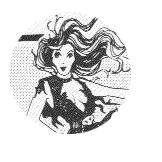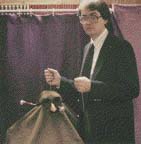  It's Halloween, the devil's holiday, and 10,000 screaming fans are watching as you strut
across the stage in your high black boots, your cape furling around you, Alice Cooper music
blasting in the background. You're in a dark mood, Lestat on a bad year, and you are about to
show the audience that this is no Kid Show Matinee. You choose to either: (A) Sever your lovely assistant's arm with a buzz saw (B) Set the poor girl ablaze until all that is left are her charred bones or (C) Visually transform a shy audience member into a raging gorilla The answer is (D), All of the Above, if you are the owner of Paul Osborne's new collection, Haunted Illusions, and you've gone to the trouble to build and rehearse these chillingly theatrical illusions. As Ghostmaster Phillip Morris points out in the Introduction to this timely book, "the theater-going public has had a love affair with the macabre." Citing the long history of theater midnight ghost shows, the ghost show items featured by David Copperfield both on television and in his road show, and the explosion of the commercial haunted house, Morris makes the case that Halloween attractions, often presented year round, constitute an extremely lucrative market. To meet the creative demands of that market, Haunted Illusions is the first full-scale collection of illusions that can either be performed on stage a la David Copperfield or as fixed attractions in a haunted house setting. The book is appropriately full of spooky drawings and of photos of various stage and haunted house productions, many of them produced by Paul Osborne himself. 
The cream of the book, of course, are the Paul Osborne illusion plans, many of which you
may
have encountered already if you've been a faithful subscriber to Genii for the past 187
issues, but
which you may also, as I, enjoy consolidated here in a themed collection. This "Haunted
Illusions" collection contains 39 illusions in 128 pages, served up with the dazzling artwork and
encouraging remarks that will convince you that you cannot only build these showpieces
yourself, but can present them as professionally as your favorite television or Las Vegas
megastar.
APPEARANCES -- If you'd like to make yourself, your drop dead gorgeous Vampira-like
girlfriend, or some
Creature of the Night appear out of nowhere, Paul provides four methods, including an
imminently practical "Quick Build Modern Cabinet," a novel "Mummy's Sarcophagus," a
spookily routined "The Witch's Cauldron," and my favorite, "The Dream Seat." The latter is
based on the famous Tom Palmer creation, "Satan's Seat." In Paul's incarnation, a tall throne
decorated with skulls and feathers and red crushed velvet is shown. Assistants briefly raise a
curtain around it, dropping the curtain to reveal the Master Magician seated in the previously
empty space. He rises and the show begins! Paul's method is more technically sophisticated
than the original Tom Palmer version and can be performed surrounded.
VANISHES -- "Executioner's Dream" is the tallest of the illusions in the book , in which the
besieged wonder
worker escapes the gallows and appears from the back of the theater. "The Jack O'Lantern Girl"
is the cover page illusion, in which your Halloween-clad beauty vanishes into the confines of a
pumpkin, her face visible through an opening in the jack o'lantern's mouth up till the last
instant, among the audience. As Paul puts it: "Miraculously, slowly but surely she contorts into
the seasonal vegetable." With a proper story line and buildup, this could be a reputation maker.
SWITCHES -- Life occasionally demands that you switch yourself or your assistant for
another individual (or, if
you are Rudy Coby, for the giant killer Puppet Boy). Paul's "Switch Wall" is the most versatile
of the three methods here. The second, "Assistant's Revenge," is a near instantaneous switch of
your heavily manacled assistant for yourself, a sort of vertical sub trunk effect. The most
directly Halloween-themed of the three is "Dracula Escapes," in which Dracula is locked into a
vertical curtained chamber that cannot possibly contain any extra human beings (or human-sized
flying rodents). As the magician approaches the chamber with wooden stake in hand, he whips
the curtain aside to reveal himself locked in the chamber and his lovely assistant now holding
the curtain. Dracula is then reproduced, safe to continue his nightly feeding, from a tipover
trunk.
SWORD CABINETS -- Three methods are included in which your teenaged counterpart of
Nani Darnell or Irene Larsen
survives being sliced and diced by various blades and swords. Although "The Blade Box" is
touted as having been performed by Karrell Fox, Jack Gwynne and Mark Wilson, my favorite
presentation is that described by Paul as having been performed long ago at a Texas State Fair,
in which a clever bit of sexual suggestion allowed "a toothless wino magician" to take Paul's
last quarter. This byplay could work most effectively today by allowing two or three boys up
from the audience.
VISUAL TRANSFORMATIONS -- Hollywood special effects would be hard pressed to
compete with these two visual and real life
illusions. "Hand of the Wolf" is a compact illusion in which your hand or that of an assistant
visually transforms to the hairy, clawed, muscular hand and forearm of a wolf. (The same
method could be used to change your hand to a skeleton hand.) "The Girl to Gorilla" is the most
elaborate illusion in the book, in which the blue-room principle is used to transform a shy,
passive young lady into a crazed, chest-beating, snarling gorilla (do gorillas snarl?). The beast
escapes from its confines and charges into the audience. (If you do go to the trouble to build this
exciting attraction, be sure to check Mark Walker's The Ghost Masters for a delightfully
scary
stunt to perform if you happen to have a gorilla loose in your audience.)
HEADACHES -- Four presentations are provided in which the assistant's head becomes the
object of the Horror
Master's vengeance. "The Decapatarium" allows the assistant's head to be removed in a box.
The point of the "Torture Chest of Burhee" eludes me: the head is twisted 360 degrees, and then
a torch is applied and two doves emerge from the head box in a flash of fire. The "Chest of
Nefertari" is a sword box for the head. My favorite in this grouping is "Death by Cremation," in
which the volunteer's flesh burns off to reveal the skull beneath as the perpetrators roast
marshmallows and steaks over the action.
MENTAL/GHOST EFFECTS -- The three items in this category all employ the stratagem of
a hidden assistant. "The Slate of
Fate" is related to Don Wayne's "Dream Vision" popularized by David Copperfield. Paul
presents it as an exhibition of ghostly writing on a large slate, although it could equally be
performed as a prediction effect. "Spirit Post" is a spirit cabinet effect in which an audience
member may be alone in the cabinet, and still tambourines, horns, and bells fly about. Although
I've never built one, Paul's "Dreadful Little Dream House" has long been one of my favorite
Paul Osborne illusions. Anything you ever wanted to achieve with The Great Leon's "Miniature
Haunted House" or Stewart James's "Sefalalgia" can be achieved with this scary little doll house.
SIDE SHOW EXHIBITIONS -- Reading between the lines, I suspect that the static, side
show illusions ("Just your eyes versus
the prop") are Paul Osborne's favorites. All of course would make wonderful displays in rooms
in your haunted house walkthrough. "The Head of Urus" and the familiar "Head on Sword"
allow your assistant's pretty head to converse with the patrons. If you don't think this is
effective, check the popularity of the "face in the crystal ball" at Disney's Haunted Mansions.
"Head-X," "The Headless Lady," and "The Reconstructed Man" produce the opposite effect, of
assistants with no heads. "The Reconstructed Man" was the first Osborne illusion I attempted
building, buoyed by the fact that Paul and his friend John built one at age twelve. "Ask Clara" is
another "conversing" illusion in which a small psychic puppet, Clara Voyant, hurls crazy
predictions and astrological reading at the customers. Her motive force is cleverly hidden by
time-honored illusion principles. "Spidora" is another talking head illusion, the famous carnival
effect of the curious fusion of a lady and a giant spider. As the Fly said in the old Vincent Price
movie, "Help me! Help me!" "Dial 666 for Emergency" is a girl without a middle effect that
strikes me as having very spooky potential, and the "The Living Half Lady" displays the live
upper torso of a woman resting on a small stand atop a table. As with most of the Osborne
illusions, there are convincing touches that make the effects truly mystifying, and "The Living
Half Lady" is definitely a case in point.
This Jim Steinmeyer designed and built illusion, which appeared on the British TV show
Secret Cabaret, demonstrates how effective and contemporary an old side show illusion can
be. MUTILATIONS -- Some of the most dramatic illusion moments involve life-threatening
mutilation, and the effects
represented in this category in Haunted Illusions are classics of the genre. "The
Egyptian Table
of Death" and "Shred Her Illusion" feature bed of spikes plots, threatening to aerate your
vulnerable assistant. "Stocks of Peril" is a sword cabinet without the cabinet, with six swords
penetrating the girl at six criss-crossing points. "The Chopping Block" is a sort of full-body
"Dissecto," while "Easy Build Guillotine" is an "easy to build, easy to troup, and easy to repair"
version of a Lester Lake Guillotine. "The Burned Alive Illusion" is the venerable Cremation
illusion, perhaps the most appropriate illusion in the book for Halloween-type performances.
What is more dramatic than a fully cremated body? (Bring back those marshmallows and
steaks!) Moving into the sawing arena, "The Lumberjack's Dream" is a head chopper/guillotine
performed with a hand saw rather than a falling blade. The final two sawing illusions, "The
Arm Amputation" and "The Buzz Saw," are grisly and often terrifying buzz saw illusions,
available here in a medium or large-scale version. These two did not appear in Genii -- I
have
not personally encountered them anywhere else in print -- and for the inventive, dramatic, and I
hope careful performer, are the two items "worth the price of the book." I note that the book is actually titled Haunted Illusions 1, suggesting that more may
follow. Of the
several Osborne illusions I've personally built for Halloween functions, two are not included in
this book, so I know that more stuff is out there. We built a Super-X from one of Paul's
full-scale blueprints, floating the girl in a Ghostbusters scenario, which was popular that
year. We
also performed his DeKolta Chair Vanish Jr., first piercing the subject's covered head with ice
picks before the vanish. As with card tricks, most illusions can be adapted to a Halloween
format with a little slightly demented thought. Until Volume 2 appears, Volume 1 will serve you
well as a source of material.
A Paul Osborne chair vanish transformed into a deadly plot For the record, I bought my copy of Haunted Illusions from Joe Stevens for $52.50
pp, but the
book is of course available directly from the author, along with most of those in the following
list, at Illusion Systems, P.O. Box 36155, Dallas, Texas 75235. Please add postage.
The Books
Illusion Systems Book One $37.50
The Plans
Won't list them all here, but Paul is currently advertising 64 plans at $25 each.
Illusion Systems' Catalogue $6
The Magazines
Genii, 187 monthly illusions to date
Back in the June 1996 issue, while reviewing the new book Seance by Scott
Moore-Davis, we included a Seance Lover's Book List. We are going to run that list again here,
because Haunted Illusions automatically earns a valued spot on that list. Also, it's
almost Halloween, and you might want to pick out a book or two from the list for your reading
pleasure.
|










